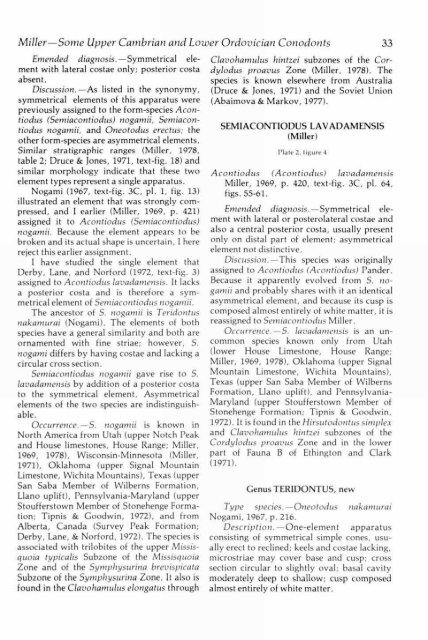View - KU ScholarWorks - University of Kansas
View - KU ScholarWorks - University of Kansas
View - KU ScholarWorks - University of Kansas
Create successful ePaper yourself
Turn your PDF publications into a flip-book with our unique Google optimized e-Paper software.
Miller—Some Upper Cambrian and Lower Ordovician Conodonts 33<br />
Emended diagnosis. —Symmetrical element<br />
with lateral costae only; posterior costa<br />
absent.<br />
Discussion. —As listed in the synonymy,<br />
symmetrical elements <strong>of</strong> this apparatus were<br />
previously assigned to the form-species Acontiodus<br />
(Semiacontiodus) nogamii, Serniacontiodus<br />
nogamii, and Oneotodus erectus; the<br />
other form-species are asymmetrical elements.<br />
Similar stratigraphic ranges (Miller, 1978,<br />
table 2; Druce & Jones, 1971, text-fig. 18) and<br />
similar morphology indicate that these two<br />
element types represent a single apparatus.<br />
Nogami (1967, text-fig. 3C, pl. 1, fig. 13)<br />
illustrated an element that was strongly compressed,<br />
and I earlier (Miller, 1969, p. 421)<br />
assigned it to Acontiodus (Serniacontiodus)<br />
nogamii. Because the element appears to be<br />
broken and its actual shape is uncertain, I here<br />
reject this earlier assignment.<br />
I have studied the single element that<br />
Derby, Lane, and Norford (1972, text-fig. 3)<br />
assigned to Acontiodus lavadamensis. It lacks<br />
a posterior costa and is therefore a symmetrical<br />
element <strong>of</strong> Semiacontiodus nogamii.<br />
The ancestor <strong>of</strong> S. nogamii is Teridontus<br />
nakamurai (Nogami). The elements <strong>of</strong> both<br />
species have a general similarity and both are<br />
ornamented with fine striae; however, S.<br />
nogami differs by having costae and lacking a<br />
circular cross section.<br />
Semiacontiodus nogamii gave rise to S.<br />
lavadamensis by addition <strong>of</strong> a posterior costa<br />
to the symmetrical element. Asymmetrical<br />
elements <strong>of</strong> the two species are indistinguishable.<br />
Occurrence. —S. nogamii is known in<br />
North America from Utah (upper Notch Peak<br />
and House limestones, House Range; Miller,<br />
1969, 1978), Wisconsin-Minnesota (Miller,<br />
1971), Oklahoma (upper Signal Mountain<br />
Limestone, Wichita Mountains), Texas (upper<br />
San Saba Member <strong>of</strong> Wilberns Formation,<br />
Llano uplift), Pennsylvania-Maryland (upper<br />
Stoufferstown Member <strong>of</strong> Stonehenge Formation;<br />
Tipnis & Goodwin, 1972), and from<br />
Alberta, Canada (Survey Peak Formation;<br />
Derby, Lane, & Norford, 1972). The species is<br />
associated with trilobites <strong>of</strong> the upper Missisquoia<br />
typicalis Subzone <strong>of</strong> the Missisquoia<br />
Zone and <strong>of</strong> the Symphysurina brevispicata<br />
Subzone <strong>of</strong> the Syrnphysurina Zone. It also is<br />
found in the Clavohamulus elongatus through<br />
Clavohamulus lzintzei subzones <strong>of</strong> the Cordylodus<br />
proavus Zone (Miller, 1978). The<br />
species is known elsewhere from Australia<br />
(Druce & Jones, 1971) and the Soviet Union<br />
(Abaimova & Markov, 1977).<br />
SEMIACONTIODUS LAVADAMENSIS<br />
(Miller)<br />
Plate 2, figure 4<br />
Acontiodus (Acontiodus) lavadamensis<br />
Miller, 1969, p. 420, text-fig. 3C, pl. 64,<br />
figs. 55 -61.<br />
Emended diagnosis. — Symmetrical element<br />
with lateral or posterolateral costae and<br />
also a central posterior costa, usually present<br />
only on distal part <strong>of</strong> element; asymmetrical<br />
element not distinctive.<br />
Discussion. —This species was originally<br />
assigned to Acontiodus (Acontiodus) Pander.<br />
Because it apparently evolved from S. nogamii<br />
and probably shares with it an identical<br />
asymmetrical element, and because its cusp is<br />
composed almost entirely <strong>of</strong> white matter, it is<br />
reassigned to Semiacontiodus Miller.<br />
Occurrence. — S. lavadamensis is an uncommon<br />
species known only from Utah<br />
(lower House Limestone, House Range;<br />
Miller, 1969, 1978), Oklahoma (upper Signal<br />
Mountain Limestone, Wichita Mountains),<br />
Texas (upper San Saba Member <strong>of</strong> Wilberns<br />
Formation, Llano uplift), and Pennsylvania-<br />
Maryland (upper Stoufferstown Member <strong>of</strong><br />
Stonehenge Formation; Tipnis & Goodwin,<br />
1972). It is found in the Hirsutodontus simplex<br />
and Clavohamulus hintzei subzones <strong>of</strong> the<br />
Cordylodus proavus Zone and in the lower<br />
part <strong>of</strong> Fauna B <strong>of</strong> Ethington and Clark<br />
(1971).<br />
Genus TERIDONTUS, new<br />
Type species. —Oneotodus nakamurai<br />
Nogami, 1967, p. 216.<br />
Description. —One-element apparatus<br />
consisting <strong>of</strong> symmetrical simple cones, usually<br />
erect to reclined; keels and costae lacking,<br />
microstriae may cover base and cusp; cross<br />
section circular to slightly oval; basal cavity<br />
moderately deep to shallow; cusp composed<br />
almost entirely <strong>of</strong> white matter.
















